A study of the 1876 Trade Dollar Type 2/Type 2 Die Marriages
With encouragement from crpyto79 to do further research into the number of 1876 Type 2/Type 2 Die Marriages, I have put together this post in an attempt to cover all die marriages. The following images are courtesy of Heritage Auctions and TrueViews used with permission from the photograph owners. I have yet to exhaust the 1876 San Francisco Type 2/ Type 2 die marriages, and will be adding more as I find them.
The shape of the olive leaves in Liberty's hand aren't nearly diagnostic as I had previously thought. They appear to swell and slim depending on the die stage, perhaps due to polishing of the dies or other reasons I don't know of. With that said, they can still be used to identify dies to some extent, just not necessarily definitively.
Before I begin, here are a few terms that I will be using.
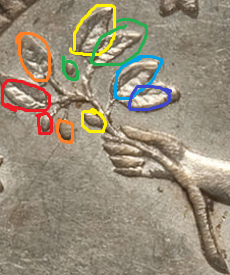
Red = 1, Orange = 2, Yellow = 3, Green = 4, Light Blue = 5, Dark Blue = 6. These numbers will be paired with "Berry" or "Leaf" in the description of the marriage.
A "centered" date will be used when the "1" in date is centered under "G" in GOD. It will also be "even" when it is seen approximately the same distance from the Motto above the date and the furthest distance from either the "8" or "7" to the denticles directly below. When the date is slanted left, the "1" is lower than the "6" and vice versa when the date is slanted right.
BS = Business Strike, PF = Proof
Without further ado...
1876 Philadelphia Die Marriages: 1 Total
Description: Recut stars, leaves, leaf #1 exhibits the most obvious recutting. It is plain to see even on an example in F that the leaf is square and I expect that it would be discernible even on an PO01 coin. Also, a prominent die chip above "Y" in LIBERTY can be seen. It is often observed with varying strengths, often very weakly on BS. An XF BS example has all traces of the die chip removed and it is barely noticeable on an MS BS example. It is readily observed on all proofs of this type, but I have not yet seen a heavily circulated proof so I do not know at what level of wear the chip is no longer visible. The following images show the proof and the BS die chip, respectively.
The 76-P II/II is a rare coin, as is any 76-P that is chopmarked, but for some reason there seems to be a disproportionate number of chopmarked 76-Ps that are II/II. It's quite possible that many or most of the 76-P II/IIs were shipped to China, while the others circulated domestically. But given the small sample size of both 76-P II/IIs and chopmarked 76-Ps of any kind I am reluctant to draw conclusions. (credits to DDR)
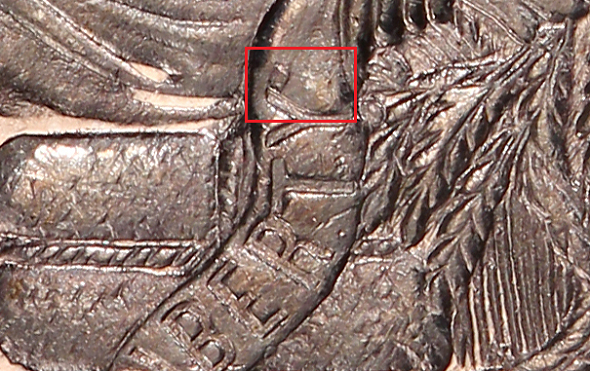 (PCGS)
(PCGS)
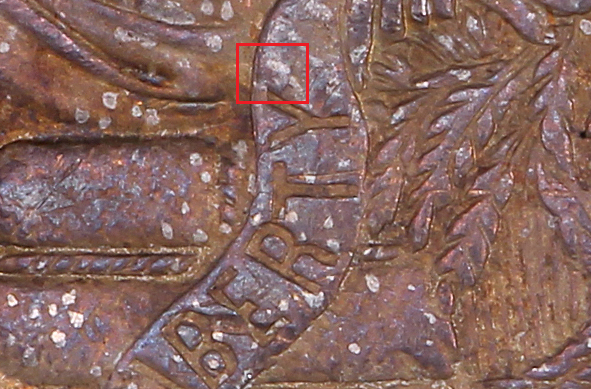 (PCGS)
(PCGS)
Proof
Date is placed left of center, about even although slightly high. Leaf #1 has squared bottom (recut) that is easily seen into even the lowest grades, leaf #5 is strongly recut, and it is easy to see the former leaf placement that was not polished out, most stars are recut as well. Reed count: ?
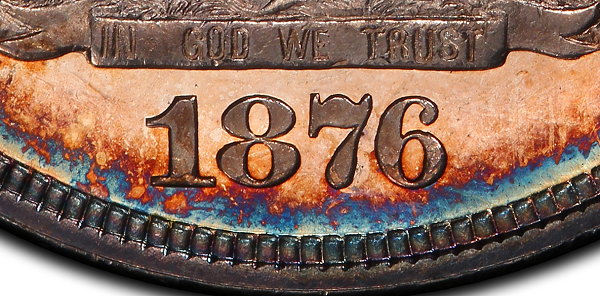 (PCGS)
(PCGS)
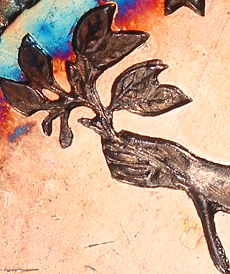 (PCGS)
(PCGS)
Example (PCGS Coin Facts): Link
Business Strike
Same die marriage as the Proof. No difference. Found with a weak strike in the Liberty's foot and in UNITED and 420 on the reverse. Reed count: 192
 (PCGS)
(PCGS)
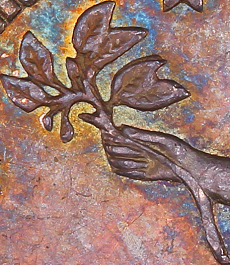 (PCGS)
(PCGS)
Example (PCGS Coin Facts): Link
Public Appearances
Proof:
8/11 - NGC PR65 $7475.00 Heritage Auctions
9/10 - PCGS PR62 $2300.00 Heritage Auctions
9/10 - NGC PR65 $6325.00 Heritage Auctions
3/09 - PCGS PR65 $6325.00 Heritage Auctions
Business Strikes:
1/13 - raw VF (unattributed) $224.74 eBay
12/12 - raw VG (unattributed) $150.00 eBay
7/12 - NGC XF stained (unattributed) $488.75 Heritage Auctions
?/12 - raw AU Env. Damage (unattributed) $?.?? eBay
1876 San Francisco Die Marriages: 13 Total
Description: There is one known DDO for this date and MM, and it is by far the rarest variety of the Trade Dollar series. The Large S reverse is second rarest for this date and MM and also difficult to find. the RPD is somewhat difficult to find, but not nearly as rare as the two aforementioned varieties. There are many other so-called "plain" versions of this date and MM that do not exhibit any doubling or perceived rarity or interest. I am confident that there are many more "plain" versions to be found. Here are the different dies used in striking not including the DDO and RPD, which are described later.
"As for the 76-S II/II, awhile back I did some research on the various obverse and reverse combinations, which was published in the Gobrecht Journal. For my research, I looked at photos of 272 76-S Trade dollars. I found that:
163 (60 percent) were I/I
72 (26 percent) were I/II
37 (14 percent) were II/II" (credits to DDR).
Collectively, we have viewed 522 1876 S Trade Dollars and only turned up 59 1876 S II/II coins. Although far from a rare coin, the 1876 S II/II only represents approximately 10% of the total population of 1876 S Trade Dollars.
Emission Order
Although it would be nearly impossible to put together an actual and accurate minting order without having each and every coin raw, I will attempt to draw conjectures between coins that share the same obverse and reverse dies based on strike, cracks and other noted die problems with explanations below.
Group 1: DDO (DDO/G), BS #8 (B/G), BS #2 (B/B), BS #11 (B/I)
Presumably, the DDO is struck first and is only used for a short period of time before mint workers notice the error and decommission the die. Then introduce Obverse B, which is paired with Reverse G to make BS #8. Reverse G is then replaced by Reverse B making BS #2, and the order is supported by noticeable die erosion on Obverse B. Further die erosion is noted on Obverse B when Reverse B is swapped out for Reverse I, making BS #11.
Group 2: BS #7 (F/F), BS #10 (D/F), BS #6 (G/F)
BS #7 is certainly struck before BS #6, as suggested by a die crack that begins to form between "O" and "L" in DOLLAR on the reverse when the die is used to strike BS #6. At the same time, a crack also begins to form across nearly the entirety of the reverse motto "E PLURIBUS UNUM." BS #10 is almost certainly struck between these two die marriages, as the die cracks in the motto strengthens but the die crack seen in BS #6 does not appear.
Group 3: BS #10 (D/F), BS #4 (D/D)
BS #10 is certainly struck before BS #4, as a die crack begins to form around the olive leaves in Liberty’s hand when it is paired with Reverse D.
Obverse
Obverse A: Date placed slightly left of centered, even. Leaf #4 is larger than all other noted 1876 San Francisco
Type 2/ Type 2 examples, leaves #5 and #6 are somewhat longer at the end than any other example, berry #3 in olive
leaves is a straight line, perhaps recut, berry #1 is seen with a straight edge. Perfectly formed hand, all fingers of proper
thickness and length, all other examples exhibit a blunted and squared away ring finger.
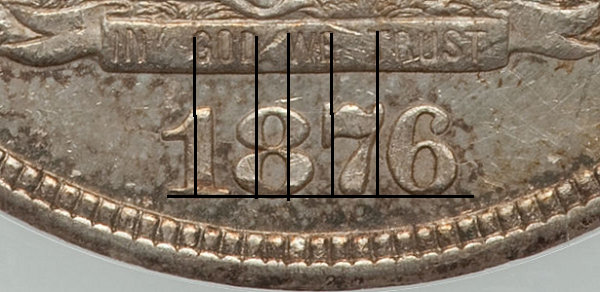 (HA)
(HA)
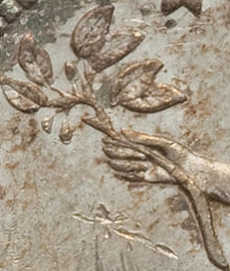 (HA)
(HA)
Obverse B: Similar placement in regards to centered as BS #1 except the date is placed slightly higher than BS #1 and
"6" is slightly slimmer on the left side. Leaf #1 is slightly smaller than all other noted 1876 San Francisco Type 2/ Type 2
examples, leaf #2 is round as opposed to every other die marriage where the leaf has jagged edges, berry #2 is
exceptionally large and prominent, but smaller than seen in the DDO. Ring finger much shorter than pinky. Stars #8,
9 and 10 are doubled to the right. This die is shared by Reverse G, Reverse B and Reverse I, which I speculate to have
come in that order respectively. My observations are based on the level of erosion of the stem connected to Leaf #5 and #6.
 (HA)
(HA)
Stars:
 (PCGS)
(PCGS)
EDS (Reverse G):
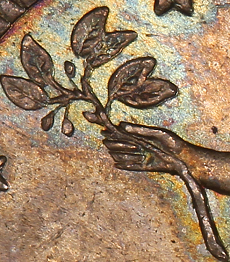 (PCGS)
(PCGS)
MDS (Reverse :
:
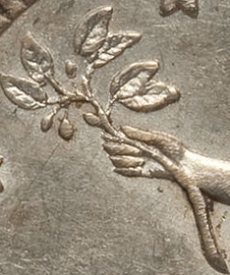 (HA)
(HA)
LDS (Reverse I):
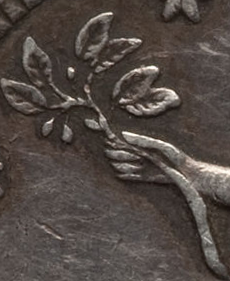 (HA)
(HA)
Obverse C: Date is placed further left of centered than BS #1 and #2, date is placed as high as BS #2, date is slanted left.
Leaf #1 is slightly bulbous on the bottom, berry #1 and #3 are especially large, pinky much shorter than ring finger,
pointer finger shorter than middle finger.
 (HA)
(HA)
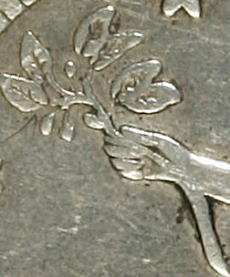 (HA)
(HA)
Obverse Date is placed slightly further left of centered than BS #3, date is placed as high as BS #3, but is slanted
Date is placed slightly further left of centered than BS #3, date is placed as high as BS #3, but is slanted
strongly to the left, top loop of "6" is closed. All berries are very small, nothing notable in the leaves. Pinky is longer
than ring finger, but not as long as seen in BS #2. Paired with Reverse D and Reverse I. Die cracks form around olive
leaves and S5. S8, S9, S10, S11 show varying degrees of recutting.
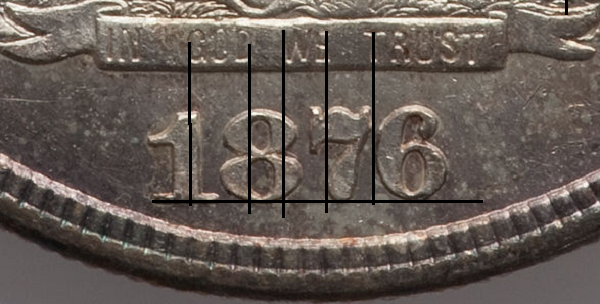 (HA)
(HA)
EDS (Reverse I):
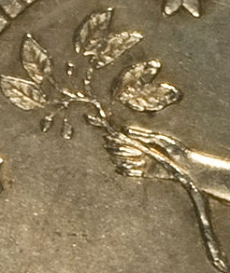 (HA)
(HA)
LDS (Reverse D):
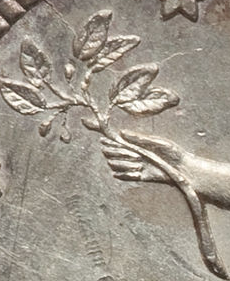 (HA)
(HA)
Obverse E: Exact same date placement as Obverse C that it is uncanny. The differentiating characteristics between these two
dies is that berry #3 is much sharper and square on Obverse E and not as large as Obverse C. Pinky is longer and better
formed on Obverse E.
 (HA)
(HA)
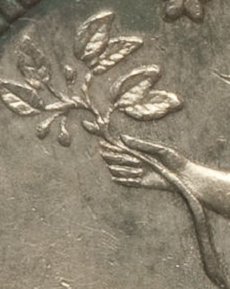 (HA)
(HA)
Obverse F: Date is right of centered and even. No noticeable slant. Pinky longer than ring finger, Berry #1 stick straight
out from the branch, Berry #3 is well formed and oblong. There are die lines near the bottom left brick upon which Liberty
is sitting. They run from SW to NE and there are four obvious lines, which are circled in red in the third image. The orange
area may be more die lines or die anomalies.
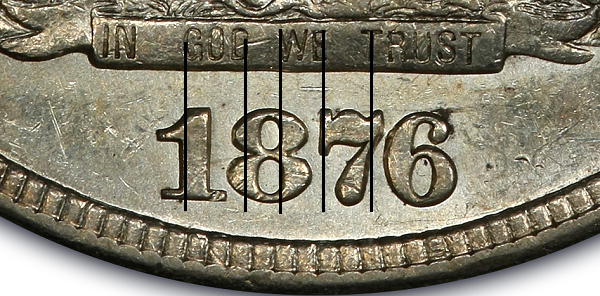 (PCGS)
(PCGS)
 (PCGS)
(PCGS)
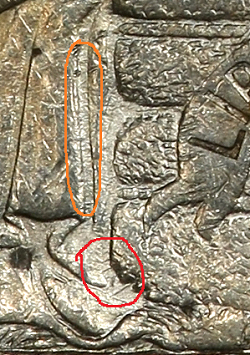 (PCGS)
(PCGS)
Obverse G: Very similar to Obverse F except date placement is completely different. Date is far left of centered and
far above even. Date is minutely slanted right. Berry #1 stick straight out like on Obverse F but is placed even further out.
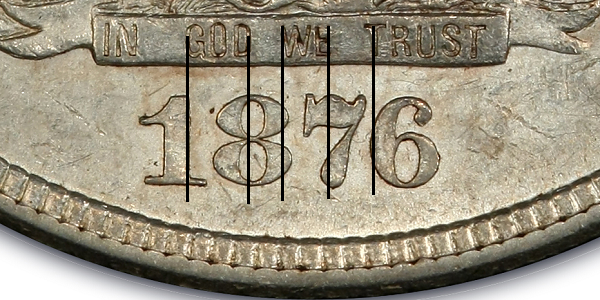 (PCGS)
(PCGS)
 (PCGS)
(PCGS)
Reverse
Reverse A: Large S, tilted left, almost centered above "D" in DOLLAR. Comma almost a circle.
Die crack forms between "ICA" in "AMERICA.”
Paired with Obverse A.
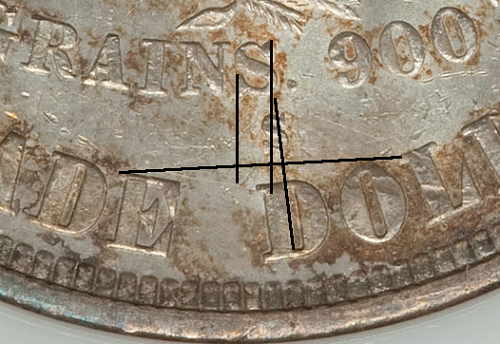 (HA)
(HA)
Reverse B: Small S, tilted right, possibly inverted, centered above the straight of "D" in DOLLAR.
Paired with Obverse B.
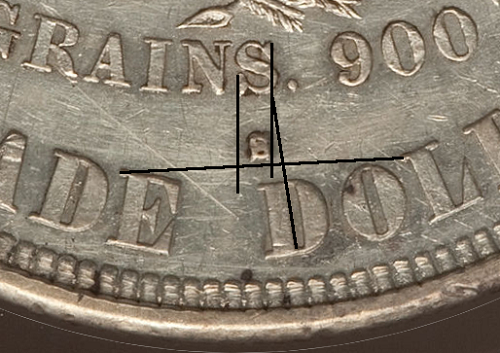 (HA)
(HA)
Reverse C: Small S, tilted right, far left of "D" in DOLLAR. Missing period after AMERICA.
Paired with Obverse C.
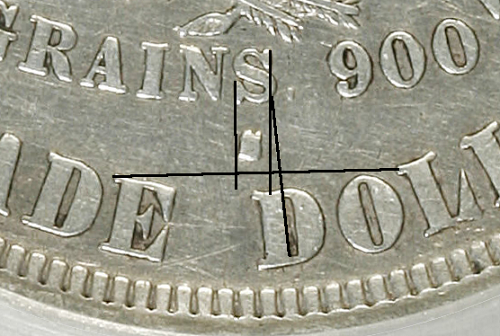 (HA)
(HA)
Reverse Small S, clear, tilted left, far left of "D" in DOLLAR. Die crack forms above OF, more observation
Small S, clear, tilted left, far left of "D" in DOLLAR. Die crack forms above OF, more observation
is needed as to whether this crack progresses or even began with the presumed initial usage (pairing with Obverse D).
Paired with Obverse D.
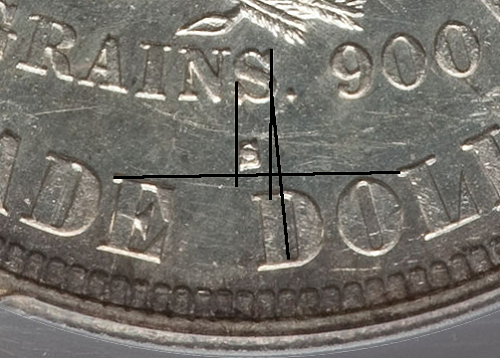 (HA)
(HA)
Reverse E: A better specimen and better picture of it must first be recovered before any diagnostics can be identified.
Paired with Obverse E.
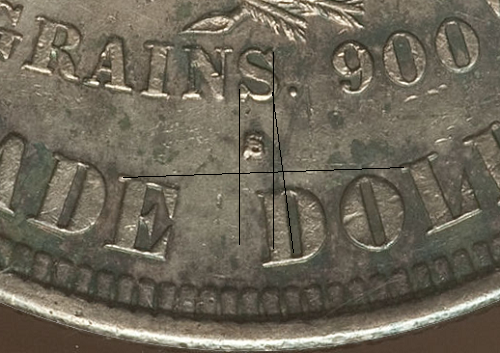 (HA)
(HA)
Reverse F: This is paired with at least three obverse dies. Obverses G, D and F.
EDS: A light crack begins to form between second U and M of UNUM in motto.
MDS: Crack between second U and M strengthens. Cracks also forms between first U and N. A die chip fills in
the upper loop of the MM.
LDS: A die crack forms between the O and L of DOLLAR by the time it is used in Obverse F. A die crack also
forms along the bottoms of PLURI in the motto. Upper loop still filled.
EDS (Obverse G)
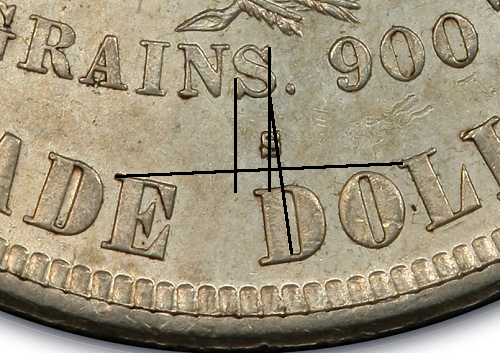 (PCGS)
(PCGS)
MDS (Obverse D)
 (HA)
(HA)
LDS (Obverse F)
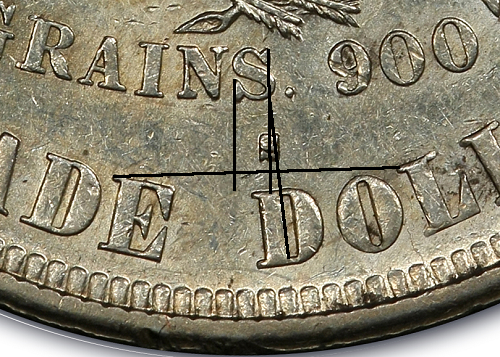 (PCGS)
(PCGS)
Reverse G: Provenance not entirely confirmed because I need a larger, higher resolution reverse image of the
DDO. Second image shows a few diagnostic die chips. The red show up more often irregardless of die state.
The orange circled ones do not always show up.
This is presumably paired with the DDO Obverse and Obverse B.
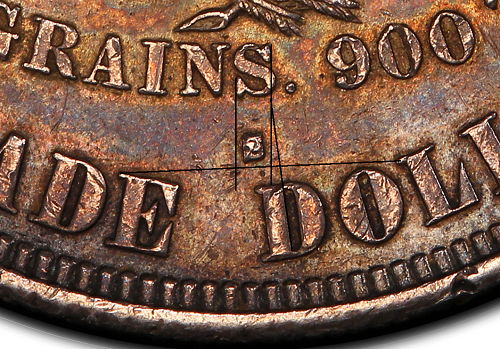 (PCGS)
(PCGS)
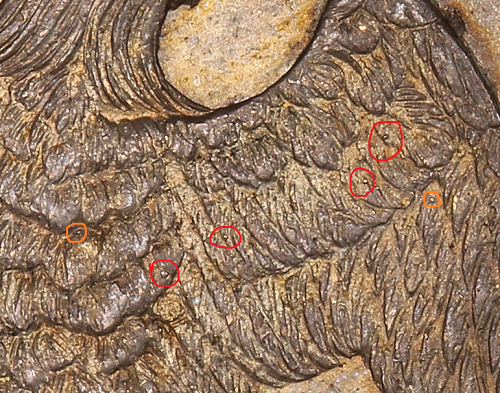 (PCGS)
(PCGS)
Reverse H: Very similar MM placement to the RPD. Possible light double die on reverse seen
in the E PLURIBUS UNUM motto and parts of STATES and AMERICA.
Paired with Obverse E.
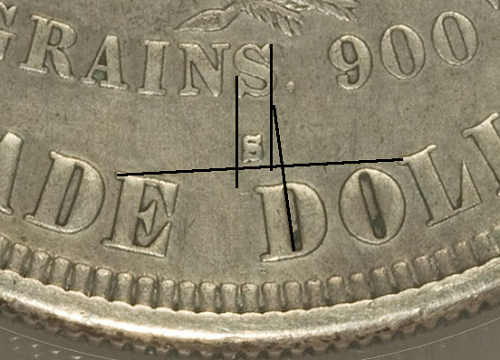 (HA)
(HA)
Reverse I: Very similar MM placement to Reverse G; however, the mint mark is not nearly
as slanted as it is in said reverse die. The comma after GRAINS is merely a tiny oval, smaller
than any other observed reverse die. The mintmark on this example is partially mutilated by a
hit on the reverse.
Paired with Obverse B (LDS)
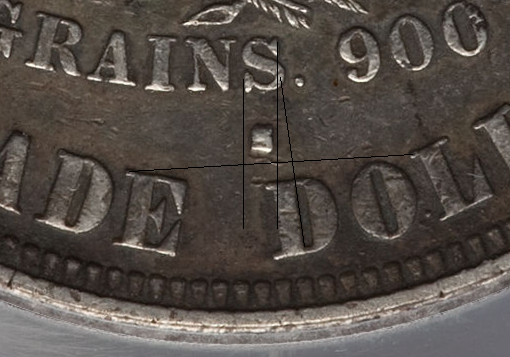 (HA)
(HA)
Die Marriages
Business Strike #1
Obverse A/ Reverse A. Reed count: ?
Example (Heritage Auctions): Link
A rare variety, this marriage is nearly as elusive as the doubled die obverse. Both Obverse and reverse
dies are so far unique to this marriage.
Business Strike #2
Obverse B (MDS)/ Reverse B. Reed count: ?
Example (Heritage Auctions): Link
Business Strike #3
Obverse C/ Reverse C. Reed count: ?
Example (Heritage Auctions): Link
Business Strike #4
Obverse D/ Reverse D. Reed count: ?
Example (Heritage Auctions): Link
From experience, this die marriage accounts for the majority of the 76S 2/2 population for whatever reason.
While Obverse D was remarried in BS #10, it is almost always observed in marriage with Reverse D.
Business Strike #5
Obverse E/ Reverse E. Reed count: ?
Example (Heritage Auctions): Link
Business Strike #6
Obverse F/ Reverse F(LDS). Reed count: ?
Example (PCGS Coin Facts): Link
Business Strike #7
Obverse G/ Reverse F(EDS). Reed count: ?
Example (PCGS Coin Facts): Link
Business Strike #8
Obverse B(EDS)/ Reverse G. Reed count: ?
Example (PCGS Coin Facts): Link
Business Strike #9
Obverse E/ Reverse H. Reed count: ?
Example (Heritage Auctions): Link
Business Strike #10
Obverse D/ Reverse F(MDS). Reed count: ?
Example (Heritage Auctions): Link
Business Strike #11
Obverse B (LDS)/ Reverse I. Reed count: ?
Example (Heritage Auctions): Link
Business Strike Doubled Die Obverse
Obverse DDO/ Reverse G
Extremely rare. Date seen right of centered, also placed slightly above even. No slant. Very large berry #2, larger than seen in BS #2, leaf #5 and #6
are blunted at the end pointer finger shorter than middle finger. Miniscule S, left of "D" in DOLLAR. Reed count:?
 (Unknown)
(Unknown)
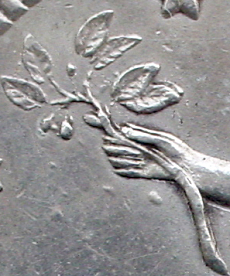 (Unknown)
(Unknown)
 (BluCC)
(BluCC)
Business Strike Re-punched Date
Date slightly left of centered, slightly slanted left, top loop of "6" is closed, extra metal inbetween the loops of the "8" on the left. Berry #3 very square, pinky finger nearly as long as ring finger. Small S, slightly slanted left, furthest left of "D" in DOLLAR, similar placement to BS #4 but placed higher. Die chip in the upper loop of “S” in mintmark. Reed count: ?
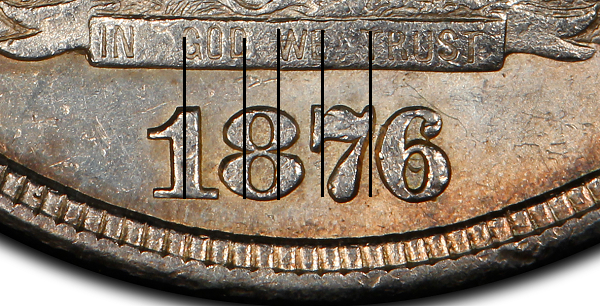 (PCGS)
(PCGS)
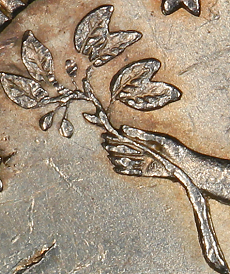 (PCGS)
(PCGS)
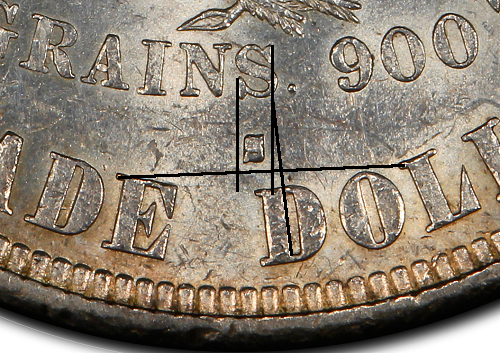 (PCGS)
(PCGS)
Example (PCGS Coin Facts): Link
D w600
H w230
M w500
The shape of the olive leaves in Liberty's hand aren't nearly diagnostic as I had previously thought. They appear to swell and slim depending on the die stage, perhaps due to polishing of the dies or other reasons I don't know of. With that said, they can still be used to identify dies to some extent, just not necessarily definitively.
Before I begin, here are a few terms that I will be using.

Red = 1, Orange = 2, Yellow = 3, Green = 4, Light Blue = 5, Dark Blue = 6. These numbers will be paired with "Berry" or "Leaf" in the description of the marriage.
A "centered" date will be used when the "1" in date is centered under "G" in GOD. It will also be "even" when it is seen approximately the same distance from the Motto above the date and the furthest distance from either the "8" or "7" to the denticles directly below. When the date is slanted left, the "1" is lower than the "6" and vice versa when the date is slanted right.
BS = Business Strike, PF = Proof
Without further ado...
1876 Philadelphia Die Marriages: 1 Total
Description: Recut stars, leaves, leaf #1 exhibits the most obvious recutting. It is plain to see even on an example in F that the leaf is square and I expect that it would be discernible even on an PO01 coin. Also, a prominent die chip above "Y" in LIBERTY can be seen. It is often observed with varying strengths, often very weakly on BS. An XF BS example has all traces of the die chip removed and it is barely noticeable on an MS BS example. It is readily observed on all proofs of this type, but I have not yet seen a heavily circulated proof so I do not know at what level of wear the chip is no longer visible. The following images show the proof and the BS die chip, respectively.
The 76-P II/II is a rare coin, as is any 76-P that is chopmarked, but for some reason there seems to be a disproportionate number of chopmarked 76-Ps that are II/II. It's quite possible that many or most of the 76-P II/IIs were shipped to China, while the others circulated domestically. But given the small sample size of both 76-P II/IIs and chopmarked 76-Ps of any kind I am reluctant to draw conclusions. (credits to DDR)
 (PCGS)
(PCGS) (PCGS)
(PCGS)Proof
Date is placed left of center, about even although slightly high. Leaf #1 has squared bottom (recut) that is easily seen into even the lowest grades, leaf #5 is strongly recut, and it is easy to see the former leaf placement that was not polished out, most stars are recut as well. Reed count: ?
 (PCGS)
(PCGS) (PCGS)
(PCGS)Example (PCGS Coin Facts): Link
Business Strike
Same die marriage as the Proof. No difference. Found with a weak strike in the Liberty's foot and in UNITED and 420 on the reverse. Reed count: 192
 (PCGS)
(PCGS) (PCGS)
(PCGS)Example (PCGS Coin Facts): Link
Public Appearances
Proof:
8/11 - NGC PR65 $7475.00 Heritage Auctions
9/10 - PCGS PR62 $2300.00 Heritage Auctions
9/10 - NGC PR65 $6325.00 Heritage Auctions
3/09 - PCGS PR65 $6325.00 Heritage Auctions
Business Strikes:
1/13 - raw VF (unattributed) $224.74 eBay
12/12 - raw VG (unattributed) $150.00 eBay
7/12 - NGC XF stained (unattributed) $488.75 Heritage Auctions
?/12 - raw AU Env. Damage (unattributed) $?.?? eBay
1876 San Francisco Die Marriages: 13 Total
Description: There is one known DDO for this date and MM, and it is by far the rarest variety of the Trade Dollar series. The Large S reverse is second rarest for this date and MM and also difficult to find. the RPD is somewhat difficult to find, but not nearly as rare as the two aforementioned varieties. There are many other so-called "plain" versions of this date and MM that do not exhibit any doubling or perceived rarity or interest. I am confident that there are many more "plain" versions to be found. Here are the different dies used in striking not including the DDO and RPD, which are described later.
"As for the 76-S II/II, awhile back I did some research on the various obverse and reverse combinations, which was published in the Gobrecht Journal. For my research, I looked at photos of 272 76-S Trade dollars. I found that:
163 (60 percent) were I/I
72 (26 percent) were I/II
37 (14 percent) were II/II" (credits to DDR).
Collectively, we have viewed 522 1876 S Trade Dollars and only turned up 59 1876 S II/II coins. Although far from a rare coin, the 1876 S II/II only represents approximately 10% of the total population of 1876 S Trade Dollars.
Emission Order
Although it would be nearly impossible to put together an actual and accurate minting order without having each and every coin raw, I will attempt to draw conjectures between coins that share the same obverse and reverse dies based on strike, cracks and other noted die problems with explanations below.
Group 1: DDO (DDO/G), BS #8 (B/G), BS #2 (B/B), BS #11 (B/I)
Presumably, the DDO is struck first and is only used for a short period of time before mint workers notice the error and decommission the die. Then introduce Obverse B, which is paired with Reverse G to make BS #8. Reverse G is then replaced by Reverse B making BS #2, and the order is supported by noticeable die erosion on Obverse B. Further die erosion is noted on Obverse B when Reverse B is swapped out for Reverse I, making BS #11.
Group 2: BS #7 (F/F), BS #10 (D/F), BS #6 (G/F)
BS #7 is certainly struck before BS #6, as suggested by a die crack that begins to form between "O" and "L" in DOLLAR on the reverse when the die is used to strike BS #6. At the same time, a crack also begins to form across nearly the entirety of the reverse motto "E PLURIBUS UNUM." BS #10 is almost certainly struck between these two die marriages, as the die cracks in the motto strengthens but the die crack seen in BS #6 does not appear.
Group 3: BS #10 (D/F), BS #4 (D/D)
BS #10 is certainly struck before BS #4, as a die crack begins to form around the olive leaves in Liberty’s hand when it is paired with Reverse D.
Obverse
Obverse A: Date placed slightly left of centered, even. Leaf #4 is larger than all other noted 1876 San Francisco
Type 2/ Type 2 examples, leaves #5 and #6 are somewhat longer at the end than any other example, berry #3 in olive
leaves is a straight line, perhaps recut, berry #1 is seen with a straight edge. Perfectly formed hand, all fingers of proper
thickness and length, all other examples exhibit a blunted and squared away ring finger.
 (HA)
(HA) (HA)
(HA)Obverse B: Similar placement in regards to centered as BS #1 except the date is placed slightly higher than BS #1 and
"6" is slightly slimmer on the left side. Leaf #1 is slightly smaller than all other noted 1876 San Francisco Type 2/ Type 2
examples, leaf #2 is round as opposed to every other die marriage where the leaf has jagged edges, berry #2 is
exceptionally large and prominent, but smaller than seen in the DDO. Ring finger much shorter than pinky. Stars #8,
9 and 10 are doubled to the right. This die is shared by Reverse G, Reverse B and Reverse I, which I speculate to have
come in that order respectively. My observations are based on the level of erosion of the stem connected to Leaf #5 and #6.
 (HA)
(HA)Stars:
 (PCGS)
(PCGS)EDS (Reverse G):
 (PCGS)
(PCGS)MDS (Reverse
 (HA)
(HA)LDS (Reverse I):
 (HA)
(HA)Obverse C: Date is placed further left of centered than BS #1 and #2, date is placed as high as BS #2, date is slanted left.
Leaf #1 is slightly bulbous on the bottom, berry #1 and #3 are especially large, pinky much shorter than ring finger,
pointer finger shorter than middle finger.
 (HA)
(HA) (HA)
(HA)Obverse
strongly to the left, top loop of "6" is closed. All berries are very small, nothing notable in the leaves. Pinky is longer
than ring finger, but not as long as seen in BS #2. Paired with Reverse D and Reverse I. Die cracks form around olive
leaves and S5. S8, S9, S10, S11 show varying degrees of recutting.
 (HA)
(HA)EDS (Reverse I):
 (HA)
(HA)LDS (Reverse D):
 (HA)
(HA)Obverse E: Exact same date placement as Obverse C that it is uncanny. The differentiating characteristics between these two
dies is that berry #3 is much sharper and square on Obverse E and not as large as Obverse C. Pinky is longer and better
formed on Obverse E.
 (HA)
(HA) (HA)
(HA)Obverse F: Date is right of centered and even. No noticeable slant. Pinky longer than ring finger, Berry #1 stick straight
out from the branch, Berry #3 is well formed and oblong. There are die lines near the bottom left brick upon which Liberty
is sitting. They run from SW to NE and there are four obvious lines, which are circled in red in the third image. The orange
area may be more die lines or die anomalies.
 (PCGS)
(PCGS) (PCGS)
(PCGS) (PCGS)
(PCGS)Obverse G: Very similar to Obverse F except date placement is completely different. Date is far left of centered and
far above even. Date is minutely slanted right. Berry #1 stick straight out like on Obverse F but is placed even further out.
 (PCGS)
(PCGS) (PCGS)
(PCGS)Reverse
Reverse A: Large S, tilted left, almost centered above "D" in DOLLAR. Comma almost a circle.
Die crack forms between "ICA" in "AMERICA.”
Paired with Obverse A.
 (HA)
(HA)Reverse B: Small S, tilted right, possibly inverted, centered above the straight of "D" in DOLLAR.
Paired with Obverse B.
 (HA)
(HA)Reverse C: Small S, tilted right, far left of "D" in DOLLAR. Missing period after AMERICA.
Paired with Obverse C.
 (HA)
(HA)Reverse
is needed as to whether this crack progresses or even began with the presumed initial usage (pairing with Obverse D).
Paired with Obverse D.
 (HA)
(HA)Reverse E: A better specimen and better picture of it must first be recovered before any diagnostics can be identified.
Paired with Obverse E.
 (HA)
(HA)Reverse F: This is paired with at least three obverse dies. Obverses G, D and F.
EDS: A light crack begins to form between second U and M of UNUM in motto.
MDS: Crack between second U and M strengthens. Cracks also forms between first U and N. A die chip fills in
the upper loop of the MM.
LDS: A die crack forms between the O and L of DOLLAR by the time it is used in Obverse F. A die crack also
forms along the bottoms of PLURI in the motto. Upper loop still filled.
EDS (Obverse G)
 (PCGS)
(PCGS)MDS (Obverse D)
 (HA)
(HA)LDS (Obverse F)
 (PCGS)
(PCGS)Reverse G: Provenance not entirely confirmed because I need a larger, higher resolution reverse image of the
DDO. Second image shows a few diagnostic die chips. The red show up more often irregardless of die state.
The orange circled ones do not always show up.
This is presumably paired with the DDO Obverse and Obverse B.
 (PCGS)
(PCGS) (PCGS)
(PCGS)Reverse H: Very similar MM placement to the RPD. Possible light double die on reverse seen
in the E PLURIBUS UNUM motto and parts of STATES and AMERICA.
Paired with Obverse E.
 (HA)
(HA)Reverse I: Very similar MM placement to Reverse G; however, the mint mark is not nearly
as slanted as it is in said reverse die. The comma after GRAINS is merely a tiny oval, smaller
than any other observed reverse die. The mintmark on this example is partially mutilated by a
hit on the reverse.
Paired with Obverse B (LDS)
 (HA)
(HA)Die Marriages
Business Strike #1
Obverse A/ Reverse A. Reed count: ?
Example (Heritage Auctions): Link
A rare variety, this marriage is nearly as elusive as the doubled die obverse. Both Obverse and reverse
dies are so far unique to this marriage.
Business Strike #2
Obverse B (MDS)/ Reverse B. Reed count: ?
Example (Heritage Auctions): Link
Business Strike #3
Obverse C/ Reverse C. Reed count: ?
Example (Heritage Auctions): Link
Business Strike #4
Obverse D/ Reverse D. Reed count: ?
Example (Heritage Auctions): Link
From experience, this die marriage accounts for the majority of the 76S 2/2 population for whatever reason.
While Obverse D was remarried in BS #10, it is almost always observed in marriage with Reverse D.
Business Strike #5
Obverse E/ Reverse E. Reed count: ?
Example (Heritage Auctions): Link
Business Strike #6
Obverse F/ Reverse F(LDS). Reed count: ?
Example (PCGS Coin Facts): Link
Business Strike #7
Obverse G/ Reverse F(EDS). Reed count: ?
Example (PCGS Coin Facts): Link
Business Strike #8
Obverse B(EDS)/ Reverse G. Reed count: ?
Example (PCGS Coin Facts): Link
Business Strike #9
Obverse E/ Reverse H. Reed count: ?
Example (Heritage Auctions): Link
Business Strike #10
Obverse D/ Reverse F(MDS). Reed count: ?
Example (Heritage Auctions): Link
Business Strike #11
Obverse B (LDS)/ Reverse I. Reed count: ?
Example (Heritage Auctions): Link
Business Strike Doubled Die Obverse
Obverse DDO/ Reverse G
Extremely rare. Date seen right of centered, also placed slightly above even. No slant. Very large berry #2, larger than seen in BS #2, leaf #5 and #6
are blunted at the end pointer finger shorter than middle finger. Miniscule S, left of "D" in DOLLAR. Reed count:?
 (Unknown)
(Unknown) (Unknown)
(Unknown) (BluCC)
(BluCC)Business Strike Re-punched Date
Date slightly left of centered, slightly slanted left, top loop of "6" is closed, extra metal inbetween the loops of the "8" on the left. Berry #3 very square, pinky finger nearly as long as ring finger. Small S, slightly slanted left, furthest left of "D" in DOLLAR, similar placement to BS #4 but placed higher. Die chip in the upper loop of “S” in mintmark. Reed count: ?
 (PCGS)
(PCGS)  (PCGS)
(PCGS) (PCGS)
(PCGS)Example (PCGS Coin Facts): Link
D w600
H w230
M w500
0
Comments
nice presentation and informative
.
bob
<< <i>Very cool, I love this stuff! I didn't realize there were this many different Small s reverses in 76. Here's a question for you, are any of the reverses shared or are all of the die marriages unique pairs? Keep in mind that some obverses could be mated with more than one reverse and vice-versa. I'll PM you some high rez pics of BS#2 and the RPD. >>
Dan, I'm not exactly sure, I'll look through more coins tomorrow to let you know, but so far I haven't seen any mixed die marriages. If there is, I'll probably have to start splitting them up into numbered obverse and reverse dies.
Up until recently I thought the 76-S Type II/II was scarce, but recently I've seen a lot of them and I've changed my mind. Your study confirms that there were enough dies to produce a larger quantity of coins. We don't know what the breakdown is between Type I/I, Type I/II and Type II/II so all we can look at is relative scarcity.
well done stealer
much better
if you do a study in numismatics and it doesn't cause a migraine, it probably isn't a study done right
.
<< <i>Up until recently I thought the 76-S Type II/II was scarce, but recently I've seen a lot of them and I've changed my mind. Your study confirms that there were enough dies to produce a larger quantity of coins. We don't know what the breakdown is between Type I/I, Type I/II and Type II/II so all we can look at is relative scarcity. >>
Dan, I can tell you this. I looked through HA's last 250 auction results and only found 22 76S Type II/II, so it is definitely much more scarce than the other groups. There are a lot of 77S's that feature small or miniscule MM's, so I wouldn't be surprised if dies were used for the next year.
<< <i>
<< <i>Up until recently I thought the 76-S Type II/II was scarce, but recently I've seen a lot of them and I've changed my mind. Your study confirms that there were enough dies to produce a larger quantity of coins. We don't know what the breakdown is between Type I/I, Type I/II and Type II/II so all we can look at is relative scarcity. >>
Dan, I can tell you this. I looked through HA's last 250 auction results and only found 22 76S Type II/II, so it is definitely much more scarce than the other groups. There are a lot of 77S's that feature small or miniscule MM's, so I wouldn't be surprised if dies were used for the next year. >>
This is really a great project Dan, I will PM you some more pictures
PHILADELPHIA: The 76-P II/II is a rare coin, as is any 76-P that is chopmarked, but for some reason there seems to be a disproportionate number of chopmarked 76-Ps that are II/II. It's quite possible that many or most of the 76-P II/IIs were shipped to China, while the others circulated domestically. But given the small sample size of both 76-P II/IIs and chopmarked 76-Ps of any kind I am reluctant to draw conclusions.
SAN FRANCISCO: As for the 76-S II/II, awhile back I did some research on the various obverse and reverse combinations, which was published in the Gobrecht Journal. For my research, I looked at photos of 272 76-S Trade dollars. I found that:
163 (60 percent) were I/I
72 (26 percent) were I/II
37 (14 percent) were II/II
So while the 76-S II/II is scarce compared to the I/I and I/II, given the fact that the 76-S is a fairly common Trade dollar to start with you should be able to find a II/II without too much difficulty.
Complete Set of Chopmarked Trade Dollars
Carson City Silver Dollars Complete 1870-1893http://www.pcgs.com/setregistry/showcase.aspx?sc=2722"
Great Job!
<< <i>Great research! To add a few more details...
PHILADELPHIA: The 76-P II/II is a rare coin, as is any 76-P that is chopmarked, but for some reason there seems to be a disproportionate number of chopmarked 76-Ps that are II/II. It's quite possible that many or most of the 76-P II/IIs were shipped to China, while the others circulated domestically. But given the small sample size of both 76-P II/IIs and chopmarked 76-Ps of any kind I am reluctant to draw conclusions.
SAN FRANCISCO: As for the 76-S II/II, awhile back I did some research on the various obverse and reverse combinations, which was published in the Gobrecht Journal. For my research, I looked at photos of 272 76-S Trade dollars. I found that:
163 (60 percent) were I/I
72 (26 percent) were I/II
37 (14 percent) were II/II
So while the 76-S II/II is scarce compared to the I/I and I/II, given the fact that the 76-S is a fairly common Trade dollar to start with you should be able to find a II/II without too much difficulty. >>
Thanks DDR, I will add those notes to the OP.
Also thanks for the numbers, assuming there are no overlapping coins viewed, we have viewed a collective 522, and seen only 59 II/II (11.3%). Definitely not rare as you mentioned that 76S is one of the most common dates out there, but relatively uncommon.
I feel that the most difficult part of this study would be to complete a relatively logical and thorough emission order, and I invite assistance from anyone if you see anything you can contribute.
I hope to move on to 76 I/II soon (in the next week or so) although I will continue updating this post as I find more tidbits. Thanks guys.
How does one get a hater to stop hating?
I can be reached at evillageprowler@gmail.com
EVP
How does one get a hater to stop hating?
I can be reached at evillageprowler@gmail.com
- new die marriage: #11
- new reverse die H
- updated Obverse B
- completed comments on reverse dies
The next project is line is to give relative rarity to these die marriages.
<< <i>Holy crap! >>
Holy Holy Holy!
Looking for Top Pop Mercury Dime Varieties & High Grade Mercury Dime Toners.
I haven't reviewed it completely, but I do have a few comments.
1. A better die marker for Obv. A is that the right side of leaf 5 is concave:
2. There seem to be typos in the descriptions of Obv. F and G.
Obv. F is date *right* of center
Obv. G is date *left* of center
3. I followed your link for BS#5 E/E because you mentioned wanting better photos.
I didn't see the bright / washed out photos you posted. Here's a Rev. E comparison, yours on the left, my download/crop on the right:
Is the link incorrect?
<< <i>My vote for faviort post of the year >>
And favorite, too!
<< <i>
<< <i>My vote for faviort post of the year >>
And favorite, too!
I blame the Iphone
Keeper of the VAM Catalog • Professional Coin Imaging • Prime Number Set • World Coins in Early America • British Trade Dollars • Variety Attribution
<< <i>there is one recent auction appearance for an over graded (JA's words) 76p 2/2 in an PCGS AU53 holder that sold for around 3300 and immediately after sold in a private treaty for 5k when the under-bidder whined to the brass and they threatened to pull the auction if a deal wasn't reached in a futile attempt to shut the under-bidder up. In other news the under-bidder has yet to shut up >>
The coin wasn't that nice to begin with but they rarely come to auction (most are privately traded). It sold for strong money at auction and foolish money afterwards. When I read Doug Winter's article on coins with bad karma, I thought of this coin. Nobody wants to touch it now.
<< <i>Wow, a nice collection of images and theories in the die markers.
I haven't reviewed it completely, but I do have a few comments.
1. A better die marker for Obv. A is that the right side of leaf 5 is concave:
2. There seem to be typos in the descriptions of Obv. F and G.
Obv. F is date *right* of center
Obv. G is date *left* of center
3. I followed your link for BS#5 E/E because you mentioned wanting better photos.
I didn't see the bright / washed out photos you posted. Here's a Rev. E comparison, yours on the left, my download/crop on the right:-
Is the link incorrect? >>
Yosclimber,
Thanks for checking my facts.
1. I hadn't noticed that before and will definitely keep an eye out for that feature from now on, many thanks! However, upon review of other obverse dies, I believe leaf #5 would be equally concave on Obverse C if I had a higher grade example to study.
2. Duly noted and corrected.
3. I actually just replaced that link last night with a new coin which I believe is correct for BS#5, but I haven't had the time to look at it extensively beyond the initial diagnostic matching. I'll try to get to that sometime today.
As higher resolution images crop up, I fully expect some dies to be abolished as duplicates of others.
1. Incredible post, very informative and a great read. A super duper job by Dan.
2. Dan needs to take up a second major or something if he has time to do this in school (then I realized he wrote it last Jan)
Great job Dan!
It may be helpful to adapt the denticle ruler metric from the Liberty Seated series, to get a more detailed measure of the date position.
It seems like the date position and mintmark position should be the primary markers for hubbed dies.
Below is my adaptation of the denticle ruler and the measurements for the photos you have provided.
I believe this adaptation is a little cleaner than Gerry Fortin's version (for Liberty Seated Dimes), which uses more notation, such as negative signs.
(Although the Trade Dollar can use a far left reference point for the 0, while on the Liberty Seated, the pendant is in the middle, so this creates the negative).
See http://www.seateddimevarieties.com/Denticle_Ruler.htm .
He uses it only for the horizontal (x) position, where it is most accurate. I extended it to the vertical (y), which may be a stretch, but might be good to +/- 0.5?
Should the 1876 business strike and proof be y3.9 or y4.9?
There often seem to be 2 levels of dentil edge.
I used the lower edge on both of these (lower level on the coin, higher vertically on the photo).
But starting with obv. die B, I tried to use the upper edge (I may not have been very consistent).
Sometimes I can't tell if the "lower edge" is just a shadow; the camera angle might not always be the same, too.
This mostly affects the y measurement, though. The x measurement should be more robust.
There is also a diagonal die defect (chip?) right/below of WE on both the above. (I assume it's raised on the coin).
Not present on the other dies below, as far as I can see.
I believe this metric makes it a little easier to see which dies have date positions that are very close to each other.
It basically confirms the reverse die groupings, although a few are close to each other.
The 0 and 5 denticles are easy to locate (for the 1876-s Type 2 reverse), because TRADE DOLLAR is close to the denticles.
I used Dan's nice method of drawing a line from the upper left top of E to L1, but I rotated the image (from 1 to 3 degrees) to make this line level.
The Y location doesn't easily map to denticles. I tried using the height of the E lower leg (narrowest part), with mixed results
(my "eyeballed" version didn't match up too well with my copied/pasted E legs).
The X and Y together still seem useful as a die marker, though.
<< <i>My vote for faviort post of the year >>
Yea, verily.
I knew there was a reason I should be checking the boards again.
I have a strong suspicion both of my '76 II/II trades are proofs misattributed as business srikes. I'll dig them out and compare them with stealer's notes.
Obscurum per obscurius